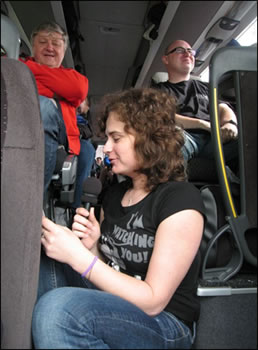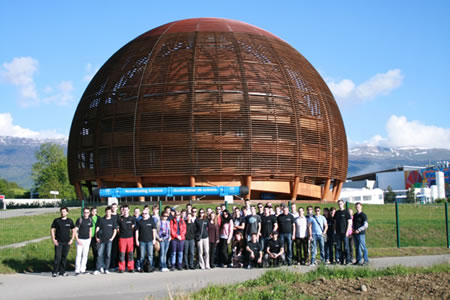
Physics on Wheels – CERN
Students at the Institute of Nuclear and Physical Engineering at the Slovak University of Technology, in Bratislava, visited the cutting-edge scientific centre at CERN (Conseil Européen pour la Recherche Nucléaire), which is located on the French-Swiss border, not far from Geneva (the state border runs right across the main CERN site, called Meyrin).

Student’s presentation in the bus
The excursion was organised by the Institute of Nuclear and Physical Engineering and the Slovak Nuclear Society as a reward for the Institute’s best performing students. The visit received financial support in the form of a Pontis Foundation Scholarship offered by Slovenske Elektrarne, a member of Enel group.

Exhibition in the Globe
The main mission of CERN is to provide particle accelerators and other equipment necessary for research in the elementary particle physics. CERN was set up in 1954 by 11 European countries and now involves 20 member states, 2,400 employees and 10,000 users from 113 nations.
Our 15-hour bus trip began on 5 May with the first of several interesting stops - at the Schaffhausen waterfalls on the German-Swiss border. An hour spent in a beautiful area with thundering water and an ancient castle was very refreshing after a night spent in the bus.
After three more hours on the bus passengers were livened up by information on CERN given by students over the on-board microphone. The information related to a variety of topics, including CERN Nobel prize-winners, particle accelerators, matter and antimatter, black holes and the highest peaks in the Alps. An hour later we were getting off the bus in the small town of Saint-Genis-Pouilly, which is located above part of the largest accelerator - the Large Hadron Collider (LHC).
The main programme began the next day, on May 7, after breakfast, when we visited the CERN laboratories. First of all we took a photo in front of Globe of Science and Innovation building – a wooden sphere that houses an exhibition featuring CERN’s activities.

In front of the Globe
Our expert guide was Peter Chochula, who works with one of the LHC detectors, called ALICE (A Large Ion Collider Experiment). He comes from Bratislava and we appreciated hearing his explanation in Slovak. In the main auditorium we learned that the LHC is the most cold and empty place in the known universe. Its magnets are cooled down to 1.9 K (universe 2.7 K) and a vacuum is a factor of 2 lower than in the universe (LHC 10-14 bars vs. universe 10-12 bars). The collider perimeter is equipped with more than 9000 superconducting magnets, producing a magnetic field of 8.6 T. The total length of the titan-niobium fibres in the magnet coils is more than 5-times the distance from the sun to planet earth.
The LHC accelerates two beams of protons or lead ions and generates 600 million collisions per second. Today, the LHC can produce particles with energy of up to 4 TeV and after its upgrade next year the figure will rise to 7 TeV. Protons enter the LHC at a velocity close to the speed of light and make 11,000 cycles per second on the LHC, which increases their energy. Among the most important of CERN’s achievements are the detection of W and Z bosons; the confirmation of three generations of mass thanks to the LHC’s predecessor – the LEP (Large Electron Positron Collider); the production of the first atoms of anti-hydrogen in 1995, (today hydrogen anti-atoms can be maintained for more than 1000 s); the demonstration of the violation of CP parity - a possible key to understanding the disequilibrium between matter and antimatter in the universe. We also learned about five recipients of the Nobel Prize that had worked at CERN and about the OPERA experiment, which is investigating the oscillations of neutrinos.
After the introductory presentation we moved to the largest LHC detector, ATLAS (A Toroidal Large ApparatuS), or rather to the building located above it, since the detector itself is 100 m under the surface and inaccessible due to the high ambient radiation levels. Our guide for the ATLAS visit was Dr. Stanislav Nemecek, from the Czech Republic. The ATLAS detector was commissioned four years ago and measures everything that happens when protons or ions collide, creating very large amounts of energy. At present, the most sought after particle is the Higgs boson that is, according to the standard model, responsible for the mass of elementary particles. We saw a 3D movie on the installation of ATLAS, which weighs 7,000 metric tons and is 44 m long. We then visited the control centre where data are collected and distributed for further processing.
Accompanied by Viliam Senai, also from Slovakia, we moved to the hall where components for the LHC are assembled and disassembled. We had a possibility to look inside the dipole and quadrupole magnets, see the accelerating cavity and learn how shrinking during cooling down is resolved. All LHC magnets are arranged with an uncertainty of 100 micrometers. The final destination, the so-called “dump” for beams from the accelerator, is the cavity in Jura Mountains - on the other side of Lake of Geneva - where an unbelievable 350 MJ of nominal energy are dumped.

ATLAS, the largest LHC detector at CERN
After lunch at CERN we continued with a visit of the Globe of Science and Innovation and the Microcosm exhibition inside. The afternoon was devoted to a sightseeing tour of Geneva. We saw its famous, beautiful water fountain, the flower watch and the place there Empress Sissi was attacked by an assassin, Saint Peter’s Cathedral. We also saw the Reformation Wall –the national monument of Geneva and Helvetia - and took a boat trip on Lake Geneva. Our programme ended at the Square of Nations.
On our way back we stopped off at Beznau NPP, which is home to the world’s oldest operational power reactor (43 years in operation with prospect of another 10 years to go). Six very pleasant ladies showed us around the plant. Beznau is one of four NPPs in Switzerland that satisfy 40% of Swiss electricity demand. The remaining 60% are provided by hydropower stations. Beznau has two units producing 365 MW of electricity. The thermal power produced by each of the two pressurized water reactors is 1130 MW. The cleanliness of all the workplaces that we visited was very impressive. All the equipment looked as if it had only been in operation for a few years, not 43 years. The cooling of the plant is assured by the river Aare, which flows around the island on which the plant is located.
Next morning, at 2:30 a.m. we arrived home, very impressed with all that we had seen during this interesting excursion.
Andrea Sagatova,
A participant in the excursion
|

